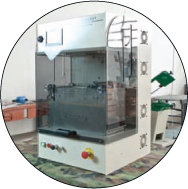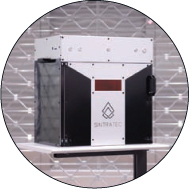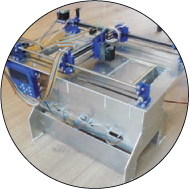Ones to Watch
Powder is coming to a desktop near you
FUSED-FILAMENT MACHINES ARE HITTING THEIR STRIDE AND RESIN-BASED printers are about to become mainstream. Meanwhile, the next generation of at-home 3D printers will use lasers, heat, or liquid to bind powders into solid materials. This process is self-supporting — advantageous because no extra breakaway branches are needed to hold up dangling parts of your print. It can also work on a variety of materials — we’ll see plastics and minerals at first, but metal-printing machines won’t be far behind. Here are a few to keep your eye on.

Blueprinter
BLUEPRINTER
Begun as a master’s thesis, Danish company Blueprinter uses a process similar to selective laser sintering (SLS), but melts the powder with a thermal printhead (selective heat sintering) instead of a laser. Priced around $25,000, the company has sold limited quantities in Europe since 2012, but is currently expanding. blueprinter.dk

Sharebot
SNOWWHITE
SHAREBOT
The Italian printer maker is expanding beyond its popular FFF machines and Arduino partnership into SLS powder printers with the SnowWhite (working name). Targeting an early 2015 launch, this printer is also expected to cost about $25,000. sharebot.eu

Sintratec
SINTRA
SINTRATEC
Switzerland-based Sintratec’s SLS printer is still in development, but they’re aiming for an unheard of price of $5,277. We won’t know the outcome of their Indiegogo campaign by press time, but using diode-based lasers instead of expensive CO2 lasers will help keep costs down. sintratec.com

Yvo de Haas
PLAN B
YVO DE HAAS
Made from off-the-shelf 3D and inkjet printer parts, Haas’ Creative Commons-licensed machine uses gypsum powder and a liquid binding agent for prints. The results are delicate and require some postprocessing. Haas puts the cost to build one at under $1,200; a work-in-progress manual is on his website. ytec3d.com/plan-b

Autodesk
SPARK
AUTODESK
With rapidly growing support before full details have been released, Autodesk’s Spark software looks to quickly become the go-to for 3D printing. It aims to provide repair capabilities, slicing, toolpath generation, and printing to local systems or printing services in one streamlined workflow from your desktop or the web.
Featuring an open API and compatibility with a variety of materials, Autodesk has already announced partnerships with Dremel (see page 56) and Local Motors (page 72) to use Spark, and their first foray into hardware, a resin printer called Ember, will help them showcase what the software can really do. spark.autodesk.com
